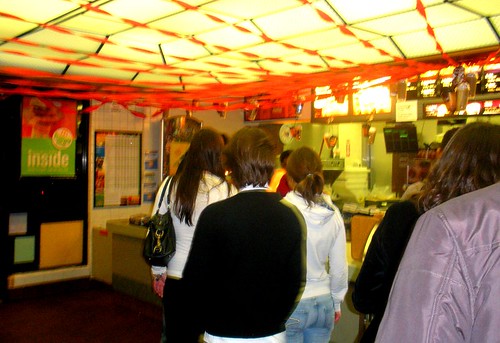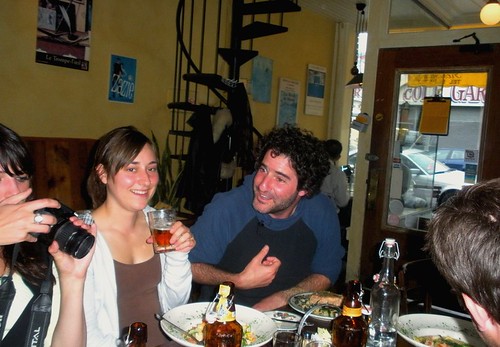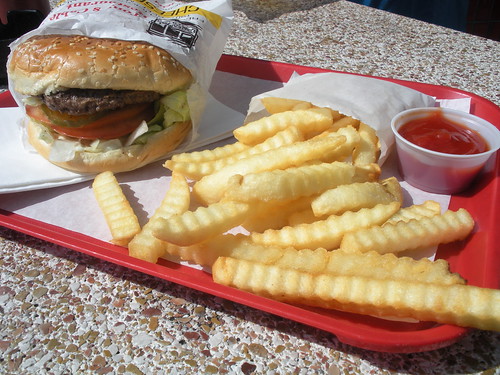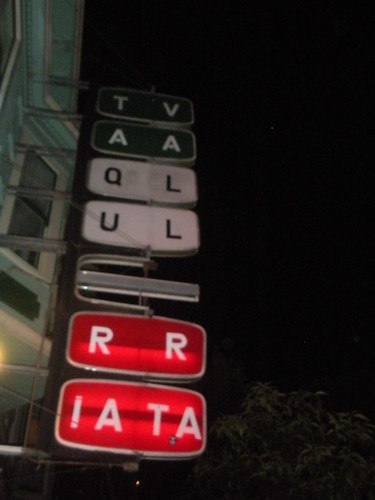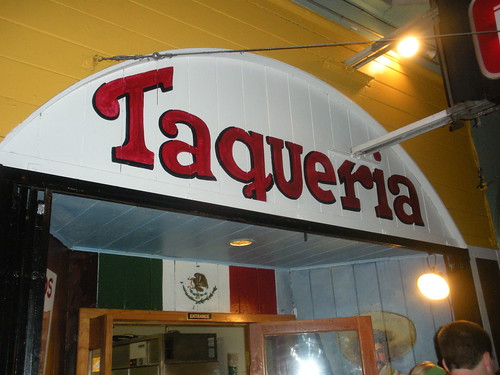05 December 2009
Multi-Media Goodness
As an aspiring journalist in this era of renovation in the media industry, one piece of advice I hear consistently is to be flexible, learn and embrace all forms of media, and be able to utilize all the technologies and platforms available. Well, here it is folks.
Below you will find a video that I filmed and edited. I wrote the words and spoke the voiceover, I conducted the interviews, and I performed the stand-ups. I uploaded the video on to YouTube.com and embedded the video into my blog. From the same reporting I did in the video, I also wrote an article that I printed in the Foghorn, the school newspaper of which I am editor in chief. I wrote and edited the text and helped lay out the content for the print copy of the paper. The story was then posted on the Foghorn Online, where readers can read and comment. I also pasted the article into my blog. After I write this, I will post a tweet with a link to my blog entry, and the tweet will be cross-posted to my Facebook account.
So I feel like I have some tools in my toolbox (as my ever-supportive Professors Toan and Vicky told me) and now I just need to continue to sharpen them.
Thanks for reading, watching, and supporting.
Foghorn Article:
USF Neighbor Opposes Removal of Cypress Trees
Tall trees are rare in big cities like San Francisco. Three such tall trees, native species Monterey Cypresses, have stood on USF property by the corner of Golden Gate and Masonic for over 70 years, and have grown to be 80-90 feet tall. Now, USF is fighting to remove these trees. However, one concerned neighbor is organizing against this process. He believes that these trees’ lives can be saved, and is protesting at an upcoming city hearing.
Glenn Loomis, director of community relations and chair of the USF Green Team, says the trees are getting taller, are top-heavy, and are possibly diseased. These conditions increase their risk for falling over in heavy winds, which would make them a potential danger to any people or property in their path.
Loomis is pushing for the trees’ removal because he is afraid of the danger that would come from them falling. Because the trees are positioned on a slope and the winds blow in from the Pacific Ocean to the west, it is likely that trees would fall right into Masonic Avenue. Loomis said, “That’s four to five lanes of traffic depending on the time of day. It’s very heavily traveled. We’re concerned that someone will be injured, or worse.”
Normally, Loomis said, USF does not ask permission from the city when trees on university property are removed. However, when trees lie within 10 feet of city property, they must seek city approval and notify neighbors. One such neighbor took issue with these trees being removed, in his opinion without reasonable cause.
Curtis Speck, the concerned neighbor, is not just an impartial passerby. Speck has been invested in USF’s foliage for over ten years. He began a garden on a plot of USF’s land, located behind the ROTC building, in 1995. Speck has a spiritual reverence for nature and plants, and gardens at USF about four mornings a week. Speck said when he heard USF planned to remove the trees, he wanted to make sure it was really necessary.
Speck said, “If we can save these trees for just a few more years, it will be worth it.”
After investigating the trees, Speck did not believe the trees needed to be removed yet. Though he is not formally educated in arboriculture, he theorizes a series of cables to hold the trees up could prevent them from falling in heavy winds. Furthermore, he believes the majority of wind is blocked by the Hayes Healy residence hall up the hill. He said, “My thinking is, are there alternatives? Are there other possibilities that we can at least consider?”
But USF has employed a professional arborist to consult on these trees, and his diagnosis is that the trees are no longer stable. Loomis said, “These are folks who are in the business not of cutting down tress, but of saving trees.” A city arborist confirmed the findings of the USF-hired arborist.
According to Loomis, the trees have consistently been maintained throughout the years, and believes their lives have already been prolonged due to proper care. However, it is simply too risky to keep them. “It’s not a matter of if the trees fall down. It’s a matter of when. And when they do, there is no question of where they will fall.”
When USF proposed the trees’ removal, the Department of Urban Forestry approved USF’s decision. Speck appealed that decision to an administrative hearing officer, but the city stood by their original decision. Then Speck took his appeal to the Board of Appeals, a higher level appeal process. This appeal gave Speck one last chance to fight for the trees he wishes to save.
Speck will argue against Loomis and other USF representatives at an upcoming hearing. The hearing will be held Feb. 3 at City Hall. If Speck hopes to see the trees stay put, he will need the votes of four out of five council members.
Loomis said, “Our position is that we want to save these trees as well, but we also want to have a neighborhood that’s safe for the students and also for the public.”
29 September 2009
Portrait of an SF Street Musician
Rich Cianfrone is a 52-year-old New Jersey native who paints houses to get by. But on the weekends – and when business is slow – he performs on the sidewalks of the famous Haight Ashbury neighborhood to keep the San Francisco Sound alive.
I met Rich outside of the Richmond District home where he rents a room. He led me up a few flights of creaky stairs to his bedroom, the small space he shares with his pet cockatiel. “My bird will be excited to meet you,” the 52-year-old New Jersey native said in his thick accent. “We don’t get too many ladies coming around here.”
He opened the door to his bedroom, the small space he and his cockatiel, a male named Claire, call home. The scents of marijuana smoke and the small animal wafts from his room into the musty hallway.
It is a sparsely decorated bedroom. The walls are white, with a few posters of bands and concerts serving as the only decorations. A twin bed covered with a brown fleece blanket hugs one wall. On the opposite wall sits a large stereo with two giant speakers. Above it are a few shelves littered with CDs of his favorite bands and a framed picture of the late Jerry Garcia. An old television squats in the corner by the window. The last wall is occupied by a white dresser, which contains all of his clothing and possessions.
Atop the dresser, his main companion Claire was climbing around outside his cage, jumping from the edges of cups and bowls. Rich found Claire in his backyard over three years ago and regards him as a son now. The bird’s sunshine yellow face and rosy pink cheeks were one of the only elements brightening up the room. Rich has three grown children, but he is currently estranged from them. No photos or remnants even hint at their existence. His marriage to their mother ended seven years ago, at which point he moved out west.
Rich is a broad shouldered man, thick with muscle from his labor-intensive day job. That day he wore a white wife-beater, a pair of light denim jeans and faded gray tennis shoes. His long hair was pulled back in a curly grey ponytail, except on the top where his bald crown shone through. He is missing a few of his front teeth, which occasionally adds an endearing lisp to his speech.
He pulled out a thirty-year-old guitar and began to play along to some CDs. “I’m a real fan of the San Francisco sound,” he said. “You know, Quiksilver, the Dead, Jefferson Airplane, Hot Tuna, The Stones, Moby Grape.” Rich was growing up in New Jersey when the San Francisco music scene was at its peak in the 1960s and 70s. But he said a Grateful Dead concert he saw with friends back home converted him from a heavy metal devotee. Now his heart lies with the artists that infiltrated San Francisco decades ago. He strummed along to the tunes he knows so well, Claire squawking along to the music.
After warming up sufficiently, Rich decided it was time to head out to the streets where he plays. He pulled a white cap emblazoned with the logo for Kelly Moore paint over his head, and lugged his guitar out the door and on two busses to get across town to where the San Francisco Sound originated: the Haight Ashbury neighborhood.
Walking up and down Haight Street, he chose what he considered a perfect spot to perform. There are many considerations that go into choosing that perfect stretch of sidewalk. For one, the spot must not be in front of an open business, or the business owner will usually shoo the busker away. Also, if it is a particularly warm day, it should be in the shade. Lastly, it must be a suitable distance from competing performers. That day, Rich was performing in front of a closed up storefront splattered with graffiti. On the corner, a young woman with long flowing hair played the violin, and midway down the block, some male guitarists were covering Johnny Cash songs.
He opened his guitar case, knelt on the sidewalk, and began tuning as though he were in his own home. He dropped a few dollar bills and change into the open guitar case to prompt others to leave tips. He stood up and began to play. His accent was just slightly detectable in song, and he strummed the guitar gruffly. But what he lacked in talent, he made up for in spirit. His own personal hardships came through in his covers of the famous tunes. And his eagerness to entertain came through in the smile he flashed at each person who passed.
The weekends draw hoards of tourists and locals to this historic neighborhood, and this sunny Saturday drew even more than usual. The crowd was mostly young and mostly fashionably dressed. Most seemed to gaze right past Rich as he began playing the old songs that once defined this neighborhood. Now trendy boutiques and souvenir shops selling reminders from the past give this neighborhood its identity.
Rich played for about an hour, making only two dollars in that time. He grew hungry and decided to get a slice of cheese pizza and a small Coke. On the walk to the pizza parlor, he stopped to give a fellow street musician advice on how to string his guitar. The two discovered they were both from the East Coast and chatted joyfully. After lunch, Rich stepped out on a side street to take a few puffs from a small joint, which he’d been storing in his zippered coat pocket. He has a regular cigarette lit simultaneously to thwart suspicion of passersby.
As the afternoon dragged on, “Why do you perform?” became the glaringly obvious question. It clearly wasn’t for the money, which wasn’t even enough to cover the cost of lunch. It didn’t even seem to be for the attention; most people seemed to glaze their eyes right past him.
Rich said, “You know, it’s like they say, why have music if no one hears it?” He continued, “For me, it’s not about the money. It’s worth more to me if someone says ‘thanks for keeping it alive’ than if they hand me a dollar. Besides, you can’t make a living doing this.”
For Rich, times have become hard. House painting jobs are harder to come by these days, he said. He blames the influx of inexpensive migrant laborers for this difficulty. Perhaps this hobby brings fulfillment to a man who is dissatisfied with work. Perhaps it fills a void that has been empty since he lost touch with his ex-wife and three children. Perhaps it brings a lost sense of community. Perhaps it makes a man whose best friend is a bird feel appreciated. Or perhaps it is, as he says, simply about keeping the San Francisco sound alive.
Rich settled back into his spot after his break. His guitar is worn out, weathered from many-a-day spent out in the elements. He flung the purple strap over his shoulder, which is so old it requires a shoelace to keep it attached to the guitar. He started to play a different kind of tune, the old Motown hit “My Girl.”
An older man walked by. His eye sparkled and he whistled along to the familiar tune. Smiling, he dropped a dollar into Rich’s open guitar case and simply said, “Thanks.”
23 September 2009
Decoding Twilight

The young adult novel series Twilight by Stephanie Meyer has become so wildly popular among young women (and their mothers) that it is worth examining. What makes these books so appealing, and what kinds of messages are they instilling into the minds of the next generation of females?
The romance novel is about the relationship between average-girl Bella and perfect-in-every-way Edward, who is a vampire. While both characters ultimately have little personality to speak of, the few details we do have about them set up a disturbing generalization about the genders. Some of Edward's characteristics include being physically strong, extremely fast, athletically gifted, a fast driver, an expert pianist, and with model-like good looks. In contrast, some of Bella's characteristics include being frail, delicate, unable to partake in athletics, even unable to do simple physical acts such as walking or hiking.
With so little depth to their personalities, one would ask why these two fall so passionately in love. In reality their love could only be described as lust. Edward’s passion for Bella is based on the smell of her blood, which is appetizing to him. In the real world, this could be compared to a man lusting over a woman solely for the appearance of her body. In both cases, her personality has nothing to do with the attraction; it is merely a physical longing, a biological drive.
In fact, Bella has almost no distinguishing characteristics, or interests for that matter, to fall in love with. As soon as she meets Edward in the beginning of the novel, she is hopelessly devoted to him, abandoning the few interests she had in the first place. For example, it is mentioned early in the novel that she enjoys reading, but seems to forget this once she meets Edward. Also, all outside friendships and relationships are forgotten; she snubs other kids at school to spend more time with Edward, spends as little time as possible with her father, and can barely find time to email her mother.
The fact that Edward is a vampire makes him dangerous and exciting to boring Bella. Perhaps this is why she is so willing to sacrifice everything in her own life, which prior to Edward, seemed to be spent primarily moping around the house. Edward's dangerous identity brings Bella into an exciting life, albeit one that is not her own. This seems to enforce the antiquated idea that women themselves lack identities; their identities are merely formed by the men they are associated with. Bella is a shell of a human, completely lacking personality, passions, interests, and talents. Her life seems pointless until she meets the man who defines her identity.
The dangerous secrets Edward shares with Bella about him and his family make their relationship instantaneously intimate. The quickness with which they declare their soulmate status (was it the first or second date?) is disturbing. Edward and Bella are declaring that they love each other, can't live without each other, and would die for each other at lightning speed. This is unhealthy role modeling for young women in their own relationships. Declaring a lifelong commitment in a puppy love relationship can ultimately lead to premature marriage, teenage pregnancy, and a lifetime of unhappiness.
Of course it is impossible to discuss Twilight without discussing the abstinence-only subtext. Upon meeting each other, Bella and Edward are extremely sexually attracted to each other, but this is complicated by Edward's desire to eat Bella for lunch. Thus, the couple must restrain their passions because sex is just too dangerous; Edward could lose control and kill her. Perhaps it is a positive message for young couples that sex can indeed be dangerous, and should not be rushed into. On the other hand, the abstinence-only message has long been proven ineffective. Besides, real-life sexual intimacy does not literally pose the risk of instant death, which seems to be the only thing restraining Edward and Bella. Thus, the novel provides no realistic argument against teenage sexual intimacy; if anything it merely intensifies the importance of sex, as it is always on the minds of the main characters.
Another observation I made about Bella's character is her peculiar relationship with food. In almost every scene when Bella is eating, it is forced. She usually skips her lunch at school, drinking only lemonade or picking at a small snack, which she ultimately loses interest in. She gets no enjoyment from her food. Every time she eats, it must be excused and apologized for. Bella’s diet seems to consist primarily on a quick bowl of cereal before school. On the other hand, she is vigilant about preparing intricate meals for her father. Though he never asked her, she takes it upon herself to prepare a hot meal from scratch every night. Bella however, is never shown enjoying the meal she’s prepared. This is a shockingly old fashioned view, the woman being the one responsible for preparing the meal for others, never the one to enjoy it. Perhaps if Bella ate more than a bowl of cereal a day, she wouldn’t be so helplessly frail and physically inept!
There are many disturbing messages in the Twilight series. Though I have only read the first of the novels, from outside reading it is clear that things only get worse from there. Bella marries Edward young, becomes a young mother, and literally gives up her life, becoming a vampire, to be with him. While many offer the argument that it is better for young women to be reading Twilight than nothing at all, I am not convinced. I only hope that these deeply disturbing messages are lost on the younger readers.
16 May 2009
Cooking with Seasonal, Regional Food

Have you ever cooked a meal of entirely seasonal and regional foods? Before last week, I really don't think I had.
Walking through the supermarket these days, you will see food coming from all around the world. Though it certainly convenient -- hey, it gives North Americans the ability to eat strawberries in December -- this global food market is also impacting the environment. Did you know that 90% of bananas eaten by people in the United States are grown in South America? How do these millions of bananas get to the U.S. from Brazil? And how do strawberries, seasonal only in summertime, magically appear in the produce section year-round? Let's just say some of your food may have more frequent flier miles than you do. Food is being shipped around the world for buyer convenience, but at the expense of the environment.
As if there weren't enough things to feel guilty about!
I was always overwhelmed by this fact. I felt helpless. Certainly I couldn't change the system. But I don't necessarily have to comply with it either.
When my Eating San Francisco class was assigned the final project of cooking a delicious dish of all seasonal, regional foods, I had a brief moment of panic. Cooking for me usually involves a trip to the grocery store and the use of at least SOME packaged or processed foods. I decided to check out a local farmers market and I hoped something would fall into place.
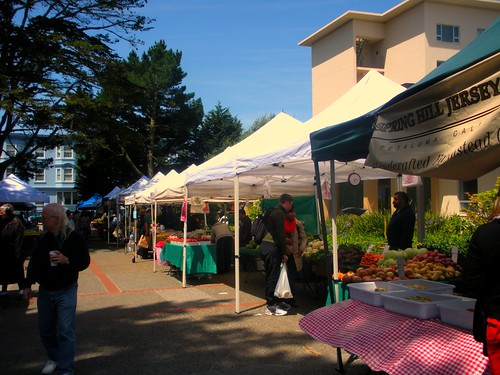
Lucky for me, my local farmers market was extremely local: USF recently started having a farmers market on weekends and, living on campus, it just doesn't get more convenient than that.
There I found an abundance of food that I would feel guilt-free about eating. Fruits and vegetables that come from local farms are not shipped halfway around the world, and the money goes directly to support small farmers and their families. And of course there are also your fresh meats, eggs, and dairy products. At a farmers market and you can assume the animals were treated way better than any you'll find at the supermarket.
At the farmers market, I met up with local food lover and recent USF alum Lulu McAllister, who secretly wishes she was in Eating San Francisco. She advised me on some ingredients to pick out, and we devised a sort of recipe for a fava bean dip with pita bread and feta cheese.
I put my recipe in a Flickr set. I think it makes more sense visually.
Look at all the delicious dishes my classmates made!!!

 Thanks for the great semester ESF!
Thanks for the great semester ESF!
11 May 2009
What's for dinner
The question of what to eat for dinner has become increasingly complicated. With new technology and more efficient farming methods, the focus of food production is all about maximum profit and with little regard to quality. Quality seems to be the lowest of all priorities in the industrial food chain, as all efforts are focused on producing massive quantities of certain foods at low costs. And consumers eat it up -- most Americans value low price above all, which is why they are willing to eat mystery meat from McDonalds, so long as it's only 99-cents.
Let's back up. In our Eating San Francisco class, we've been lucky enough to eat at some pretty cool and interesting restaurants in one of the greatest culinary cities in the world. Our plan all semester was to end class by reading Michael Pollan's The Omnivore's Dilemma, and dine at none other than the McDonalds conveniently located on Haight Street.
But as we read Pollan's masterpiece, which explains just how screwed up America's food industry is, the thought of eating at this mega-chain (which is no worse than its competitors, but for better or for worse has become icon for fast food, and thus the brunt of all criticism) was no longer very appealing.
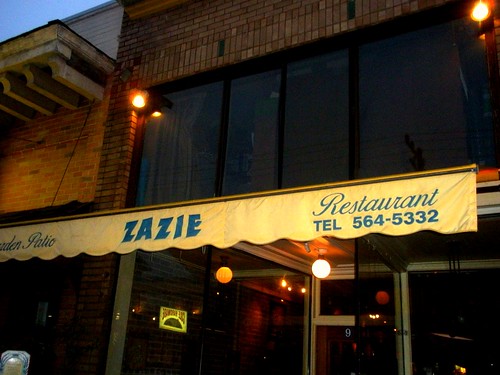
So our class decided to go to Zazie, a French Bistro in nearby Cole Valley. At around $15-20 per dinner entree, this place was clearly a cut above good old Micky-Ds. And oh, was it a noticeable difference! The quality was evident in the service and meal. It was the kind of place where the food was truly special, and the reason for being there. The waitress chatted with us about her favorite dishes and spoke enthusiastically about what drinks should accompany it. When the food was presented, each dish was a work of art.

I ordered salmon, and it was laid over a bed of couscous and sprinkled with fresh herbs, sweet cherry tomatoes, snap peas and a wedge of lemon. It was so fresh and well seasoned that each bite was exciting. Also, the food looked like what it was: the fillet of salmon clearly was fresh from the sea - no unnecessary processing or preservatives. The vegetables were fresh, not frozen, and came from local farms. Couscous is a processed wheat product but is still fairly natural, as it is an ancient dish, not a byproduct of the modern food industry.
There was something so pure and good about the meal. It's the feeling of eating "real food," not something we always get these days.
In comparison to Exhibit B: Fake Food

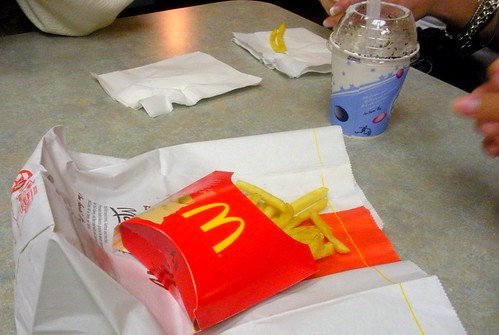
After dinner we headed over to McDonalds to basically fulfill our obligation of eating there. I eat at McDonalds from time to time, but it's not a decision I like to consciously think about. Having just read The Omnivore's Dilemma, and just dined on such high quality food at Zazie, the idea of McDonalds did not seem appealing.
In his book, Michael Pollan talks a lot about McDonalds. The most astounding point he makes about fast food (and all industrialized food) is that it is made up primarily of corn, due to corn farmers constantly growing a surplus and selling it for various uses (from feeding livestock to fueling cars as ethanol) on the cheap.
The French fries, for example, would seem to be a potato product, but really half of the calories come from corn, in form of the oil they're fried in. Or the McFlurry (I enjoyed an Oreo one that night) seems like an ice cream dish, but contains plenty of corn: corn syrup solids, mono and diglycerides (from corn) and milk from corn-fed cows. The chicken nuggets and hamburgers: corn. The soda: tons of corn. You'd really have to read the book to understand just how much corn goes into the food we eat. Pollan doesn't conclude that this is going to lead to mankind's extinction, but it sure doesn't seem like a good idea.
Comparing the two dining experiences, there was really no contest. Zazie was a relaxing culinary experience. We wined and dined slowly, conversed merrily, and practically licked our plates clean from the delicious entrees.
At McDonalds we were herded like cattle into a line where we ordered, waited, went up to the counter to retrieve our feed, and sat down at tables. We bussed our own trash. The employees seemed irritated that our large group had come. They told us not to take pictures. The food tasted good, but in that manufactured kind of way. The McFlurry had a fake feeling, not like real ice cream. It is cold and sweet but there is something different.
Nonetheless, there are obvious reasons we can't all eat at Zazie every night. For one thing, the price would make it impossible for many people to go. I personally could only go as a rare treat. My meal cost $16, which I would make in about two hours of working. I'd go broke in a hurry eating like that. Also there's the time factor. We spent about two hours at Zazie, whereas most days I devote about a half hour to eating dinner. If I had to eat out on a typical day, I'd have to go somewhere that could serve me quickly. And cheaply. Hence the reason why I do eat fast food occassionally.
However, reading The Ominvore's Dilemma has made me more conscious of the impact of these decisions. I do feel inspired to make an effort to eat whole, natural foods more often. There are farmers markets all over the city that put local, organic produce just a walk or busride away. While I may not be resolving to abstain from meat or fast food altogether, I am determined to make small, positive changes for the sake of the earth and my own health.
05 May 2009
The Foghorn: A year in review
But tonight that is not the case. The school year is quickly wrapping up, and the paper has gone to bed for the semester, leaving me and my colleagues to run around like chickens with our heads cut off with no paper to attend to until next fall. What do normal people do Monday nights?
This time has given me a chance to reflect on the crazy, crazy year the Foghorn has had. It really was groundbreaking, and not to sound self-important, but it was perhaps one of the most significant in the paper's 106 years.
I say this almost primarily because of the new website. After several years of an unimpressive online site, the Foghorn now has a dynamic, interactive, multimedia supporting and, most importantly, fun to utilize web PRESENCE. Yes the word presence is important. Presence implies that people know we are present, which they do. By the time content is uploaded to the site, often before the PAPER paper has been distributed around campus, page views are already soaring, and comment discussions beginning to heat up. There is an online presence.
Eternal thanks go out to Michael Villasenor for this, a USF senior and web guru, who envisioned and created the site. His creative vision and technical expertise made the site all that it is today: user friendly, engaging and community oriented with minimal technical difficulty.
Having the Foghorn Online become so important has helped the Foghorn in paper as well. I know I personally have stepped up the quality of stories I am working on and am taking extra care to cover things fairly. Heaven forbid, I think, if I covered an important story unfairly, I would be attacked by the online commenters. If the press is supposed to check big business and government, then finally readers have the opportunity to check the press, beyond a letter to the editor. There is now instant feedback, completely public for the world to see. Let's just say I'm being more careful than ever. I'm also choosing to cover more stories that are of significance to the community because, from an egotistical standpoint, I want to see people reading and discussing my articles. I expect other writers feel this way as well. This concern for what the readers want is obviously what we should have always been doing, but now it is just more clear to see what readers enjoy.
This has also been a year filled with some significant news in the University community. An alleged rape case made headlines around the Bay Area when a senior in the ROTC program was accused of rape by four unique female students, and I covered this for the Foghorn. It was one of the most interesting experiences I ever had as a student journalist: real news, right on my campus. The full news story can be read here. I also covered much of the aftermath: student reactions and anti-rape events. The whole issue also sparked a series of very thoughtful opinion columns by community members; such a great dialog I will never forget.
It was also the year that the 44th US President Barack Obama was elected and inaugurated into office, which I covered for the Foghorn as well. The night he was elected, sharing that moment with my campus community, and then heading into the newsroom to type up a story in time for print -- definitely something to tell the grandkids about.
I have also covered controversies involving USF faculty: a popular professor Andrej Grubacic not being rehired and faculty union negotiations (which I did a rather shoddy job at, but read anyway if you must).
After this monumental year, the Foghorn staff was surprised to have our stipends cut by the student government. Rather than sit idly by, we wrote an impassioned staff editorial. This article, within hours of being posted, received more comments than any other article ever posted to our site. Though I did not write this piece, it inspires me to see how powerful the Foghorn Online can become. The readers, the USF community, can have an extremely powerful voice. After this was printed (and we filled out a formal appeal), our stipends were almost completely reinstated. Perhaps because the student body at large was so widely in support of us. That felt good.
This year I went from co-news editor to managing editor of the Foghorn. Next year I will take over for the infamous Hunter Patterson as editor in chief. Hunter leaves large shoes to fill, not to mention he's pretty much the only EIC I've ever known here at the Foghorn. I am excited for another tumultuous year with the newspaper, hopefully with more drama and breaking news than ever.
Thanks for reading.
25 April 2009
Dim Sum for Dim Dummies
I'd been to Chinatown in the past, but mainly to the main tourist drag: through the Dragon Gate leading from Union Square area to Grant Avenue, which is lined with an endless array of souvenir shops. But I knew there was much more to this historic neighborhood than just cheap Buddha statues and paper fans and dragon-motived knick knacks.
A bit of online reading gave me a good sense of the history of this neighborhood. Chinatown actually started out as a ghetto for Chinese immigrants in San Francisco, when they began arriving in the 1850s in waves to work as cheap labor on the railroads or Gold Rush miners.
Americans soon began feeling hostile toward their new neighbors because they worked so hard for so little money and were coming in such an influx that jobs were at a shortage. Government began to enforce this discrimination with legislation such as the Chinese Exclusion Act of 1882.
Despite these restrictions, Chinatown continued to flourish as a hub for Chinese immigrants, with schools, churches and shops owned by Chinese people.

Nowadays Chinatown is somewhat touristy and Disneyland-ified (given an exaggerated theme to draw more visitors), but it is not all a facade. Between the crowded sidewalks full of Chinese shoppers stocking up on fresh groceries and store owners tending to their small shops and markets, peppered with lively conversations in Cantonese, I actually feel like I've stepped into another country when I walk around there.
When I went with my ESF class, we stopped at the Tin How Temple, a dim sum restaurant called New Asia Chinese Restaurant, and finally to the Golden Gate Fortune Cookies factory.
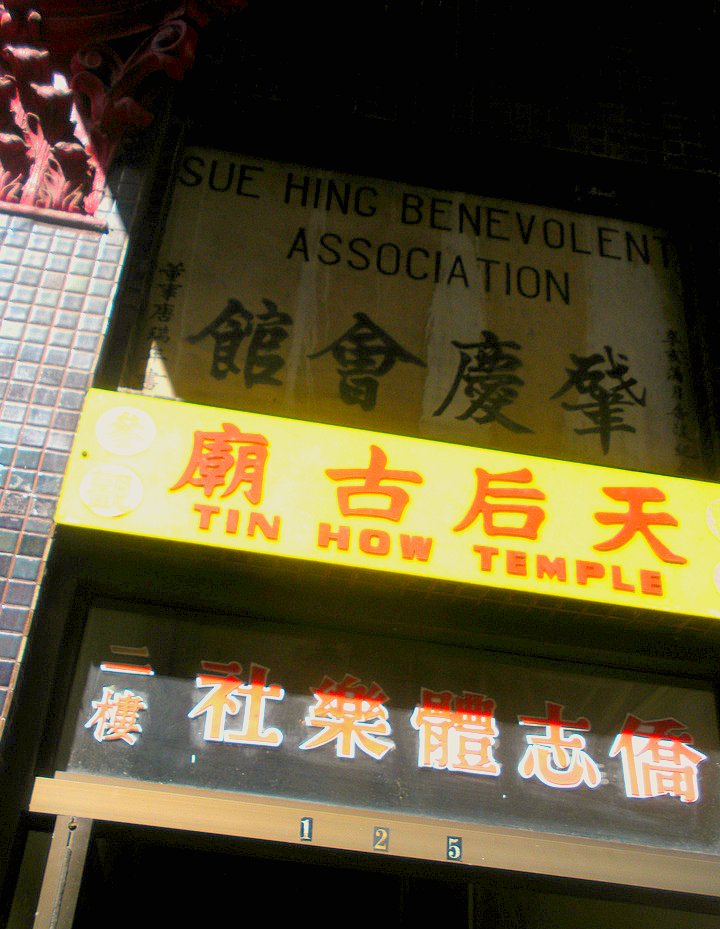
The Tin How Temple is the first Chinese Temple in the United States. Walking inside, up about four flights of narrow stairs and finally into a tiny room, it was a wonder that anyone could ever find this place. The room inside was filled with the fragrant smoke of incense and stung my eyes. A group of elderly Chinese women seemed to be running everything here. One very kind woman showed our class many aspects of the temple unfamiliar to us and taught us how to ask for a fortune. Turns out you don't just crack open a cookie. I enjoyed learning about the rituals observed in the temple, which were new to me.
Next was brunch. I was starving by this point! We crawled out from the dreamlike haze of the temple into the bright daylight, ready for dim sum. We were walking through streets I had never been on before and I began to understand that Chinatown is for more than the tourist trap I previously thought it was. Many Chinese-Americans perused the streets, doing their everyday grocery shopping or meeting for a meal. Most of them seemed to be meeting at New Asia like we were -- it was absolutely packed inside. It's always a good sign to see locals dining at the establishment you choose, which seemed to be the case.
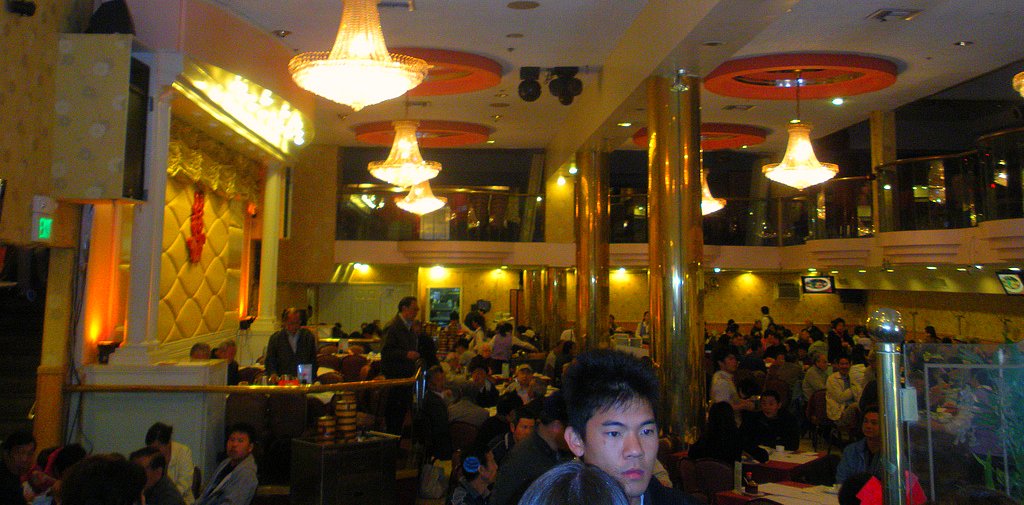
The restaurant was a huge open room full of many round tables, each surrounded by many chairs, all of which were filled with hungry patrons. Weaving between the tables were waiters wheeling carts of small dishes meant to be shared by the groups.
Finally seated, food was instantly presented to us by some rather pushy servers. They would usually hold a dish out to us, expecting an instant reply of "yes" or "no." They had little patience for questions or hesitation. We seemed to be choosing randomly. I had no knowledge of popular dim sum dishes prior to this, but it seems we tried most of the ones other tables had, and a few others.
Over all I felt pretty overwhelmed by the dim sum experience. It was a bit stressful trying to be mindful of servers shoving food at you constantly and trying to decide if you wanted it or not. Being a somewhat picky eater, a lot of the dishes looked off-putting to me. I tried most and was often pleasantly surprised that I liked them. However, others I would rather not have tried. What I did enjoy most about the dim sum meal is that it was very interactive and made us focus on our food, discussing what we liked and what we should order next as a group.


We walked off our meal as we strolled over to the Golden Gate Fortune Cookie factory. Like the temple, it was tiny, located in an alleyway with a barely noticeable storefront. Inside we got to see fortune cookies being made, from flat discs made by a small machine and then folded in half with a fortune inside by hand. This process was mesmerizing to watch.
I was happy to have spent this day with ESF in Chinatown. It gave me a fresh perspective on the neighborhood that I thought was a mere tourist trap. It also gave me my first taste of dim sum, which I think, with more knowledge and experience under my belt, I will someday enjoy very much.
By the way, in my reading I found this fascinating account from a former chief of police Jesse B. Cook (1860-1938) where he describes Chinatown's sordid beginnings, which included gambling, prostitution, opium dens and gang wars. A fun and interesting read from a white man trying to keep the "Chinamen" under control, with some great old photos.
24 April 2009
Cooking for my family
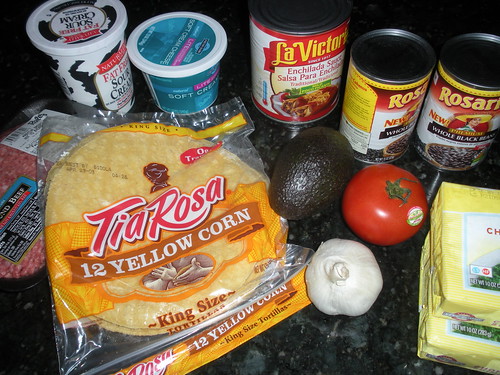





Step 1: Coat the baking pan with some canned enchilada sauce.
 Step 2: Top a medium corn tortilla with desired fillings. In this case, spinach/cheese blend, enchilada sauce, and ground beef.
Step 2: Top a medium corn tortilla with desired fillings. In this case, spinach/cheese blend, enchilada sauce, and ground beef.
 Step 3: Fold both ends of tortilla over and place in saucey baking dish.
Step 3: Fold both ends of tortilla over and place in saucey baking dish.


Ta da! I baked for about 25 minutes in a 350 degree oven. Taking them out of the oven, they looked saucy, cheesy and gooey.



Alas! the final product:

I'm so glad to have made this delicious dish. I finally gained some confidence in my cooking skills. Sharing the meal that I prepared with my family made me feel like I was able to give back to the people I love. Also, my ability to cook a meal (main course, side dish and salad!) from start to finish was finally recognized... Victory!
18 March 2009
What I ate today
My personal eating philosophy is kind of non-existent, other than trying to eat moderately healthily with very little time and money to spare. Being a college student, I think I do better than some (I don't eat Top Ramen EVERY day, though I do have it on hand), but I could certainly improve the sophistication of my diet.
Here is a typical day in the life of me. I find it impossible to separate what I ate from what I did in that day. What we consume has so much to do with our circumstances -- if we're out or at home, if we're busy or if we have the day off. Just a thought.
I rolled out of bed at 11 am yesterday. I had worked from 2 to 6 am the night before and could have slept til 1 or 2 in the afternoon if my alarm hadn't interfered. I had to get up to clean my room and then go down to the DMV to register my car. I didn't think to eat breakfast in my quasi-comatose state, but did have the strength to down a quick Five Hour Energy. I love these things.
 Completely shameful. I don't know what's in these things. Supposedly it's like a shot of straight vitamins and a little bit of caffeine, but somehow I don't think I'd consider it a health food.
Completely shameful. I don't know what's in these things. Supposedly it's like a shot of straight vitamins and a little bit of caffeine, but somehow I don't think I'd consider it a health food. On my walk to the DMV I had to stop at the bank and while doing so, got a drink at the grocery store next door. It was a warm day out, I was parched, and my sleep-deprived one-track mind couldn't resist another drink that promised me increased energy.

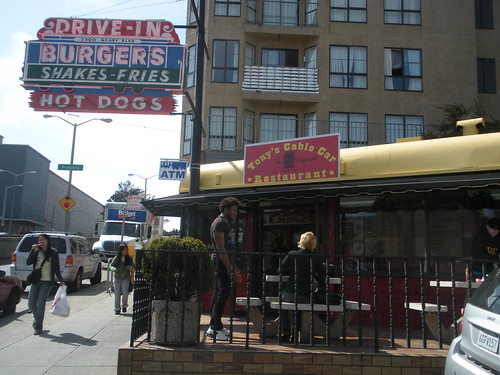
Don't know who Tony is but I love his little cable car shaped restaurant just a hop skip and jump away from USF.
At 8:00 I had a meeting for the Residence Hall Association, for which I am in charge of producing their newsletter called The Final Flush. Our president, Hoa, made delicious chocolate covered almonds that she chose to share with us, and which I neglected to photograph. Oops! Thanks Hoa!
9:15 and time for dinner. I trekked home and pulled out of the pantry a can of tomato soup, some bread and cheese. Voila! Grilled cheese and tomato soup.
 No I'm not five years old. If you haven't eaten this since you were a kid, you should revisit it. It's quite the culinary combo I must say.
No I'm not five years old. If you haven't eaten this since you were a kid, you should revisit it. It's quite the culinary combo I must say.And there you have it: A day in the life -- of me and my stomach.
For kicks I decided to evaluate my daily diet on a few of the different scales that the world wide web has to offer.
First I calculated the carbon impact of my diet using a calculator at EatLowCarbon.org

It's hard to read in this screen shot, but the site said I'd used 2,756 CO2e (carbon dioxide equivalent) points in my day of eating. These came almost all from the hamburger I'd had at lunch, as the production of beef is incredibly taxing to the environment. My entire day of eating contributed about 4.4 pounds of carbon into the atmosphere. Eek!
Next I decided to track the healthfulness of my diet using MyPyramid.gov. I had to sign up for an account, enter my height/weight and what I ate for a day, and then it told me how I did nutritionally.

I don't think this was entirely accurate. I'm pretty sure I consumed more than 1119 calories and from the looks of this chart I'm practically malnourished, which is hardly a reality. Still if I took the time to do this more accurately an regularly, I would probably get a good sense of my overall health.
And that's the flipside to eating... There are always repercussions to the choices we choose. Who knew that even something as simple as deciding what to have for lunch has repercussions on our body and our earth's environment?
12 March 2009
The woes of being an extremely amateur blogger
 The stats depicted in this chart in no way reflect my own. This chart is taken from Google images from a blog or web site with over 30,000 visitors a month. I probably have around 150 visitors a month. If I'm lucky.
The stats depicted in this chart in no way reflect my own. This chart is taken from Google images from a blog or web site with over 30,000 visitors a month. I probably have around 150 visitors a month. If I'm lucky.One surprising observation I made is that even when I am not blogging regularly (i.e. 99% of the time) I still get a fair amount of page views. This is pretty surprising because I really don't know who would be looking on my blog. Fortunately with StatCounter, I am able to see how and why they are finding it.
For example, one entry I wrote for my Digital Journalism class last spring is often searched on Google. It is about Makoto Hagiwara, the original landscape designer and maintainer of the Japanese Tea Garden in Golden Gate Park. Through StatCounter I learned that many people were searching Google for information about him, and found my blog entry as a result. Very cool!
Sadly, I have also learned a harsh reality that many people who find my blog soon choose to turn around and leave before they even make themselves comfortable. A whopping 61% of visitors stay on my blog for less than five seconds. LESS THAN FIVE SECONDS!?!? Is it really that bad?
Ok, ok, so I won't take it personally.
I've chosen to use the information from StatCounter as inspiration to blog more often and about a wider variety of topics. Seeing that a random topic such as the Japanese Tea Garden could generate so many page views is inspiring to write and write and write some more! Write about odd and interesting things that no one else is writing about. Then more people will randomly stumble upon my blog, and who knows... maybe if it's interesting enough, they'll want to stay for more than five seconds.
11 March 2009
The San Francisco Burrito
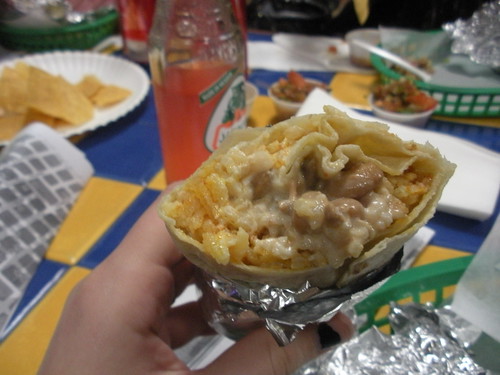
The San Francisco burrito is not traditional Mexican fare contrary to popular belief. Though small tortillas wrapped around meat and beans were served in Mexico as the first burrito, only in San Francisco did the burrito evolve into what most Americans recognize today. The defining features of a San Francisco burrito are an over-sized flour tortilla, stuffed with rice, beans, cheese, meat, salsa, and sometimes avocado, salsa, sour cream, onions, tomato, cilantro, etc. This basic concept has taken off in popularity and it is now standard to find a similar entree everywhere from Chipotle to Chevys.
The San Francisco burrito got its start when farmers in the Central Valley of California needed a cheap filling meal to give their immigrant workers on their lunch break. Most of these workers came from Mexico and Central America. The giant tortillas stuffed with hot, filling ingredients was just the right fuel to keep the workers going all day.
The rice and beans, are at the foundation of this. Rice and beans have long served as sustenance in the Latin American and Carribean cultures. The combination of the two are not only tasty but more importantly are incredibly dense in nutrtitional value, with fiber, vitamins, minerals, and when combined, form a perfect protein. This makes it the perfect basis for a filling and nutritious meal. When combined with meat, cheese and flavorful salsa, it is the perfect meal to fill you up and provide a tremendous amount of energy.
The burrito came to San Francisco as waves of Latin American immigrants came into the Mission District, replacing the Polish and Irish cultures that were dominant at the time with their own. The Latin American culture is still dominant today. With their taquerias and bakeries and churches and colorful murals splashed throughout the neighborhood, the Mission now has a strong Latin American influence. But stepping into the neighborhood isn't exactly like stepping off an airplane onto Mexican soil. It represents a fusion of the different cultures of Latin America all coming together in a diverse urban city. Likewise, the burrito is not a traditional dish from any one Latin American country, but it uses popular staple ingredients from the Americas, wraps them up in an all-encompassing tortilla, and serves them up to anyone and everyone.
To experience this cultural fusion, my Eating San Francisco class met in the Mission District last Wednesday at Balmy Alley, one of the premiere mural spots in the neighborhood. Murals and street art have been used in the Mission for decades to express political and social concerns of the Latin@ culture.
From there we headed to a taqueria just around the corner. I've probably been to at least 10 taquerias in the Mission, and I swear I've barely scratched the surface. This one, called Taqueria Vallarta, was new to me and I was excited!
The inside was kind of funky. There were murals all over the wall, and although done in the realistic style of Diego Rivera and other Latin American muralists, they incorporated modern imagery of local landmarks and athletes. Not exactly the kind of political message murals usually incorporate, but fun and colorful nonetheless.
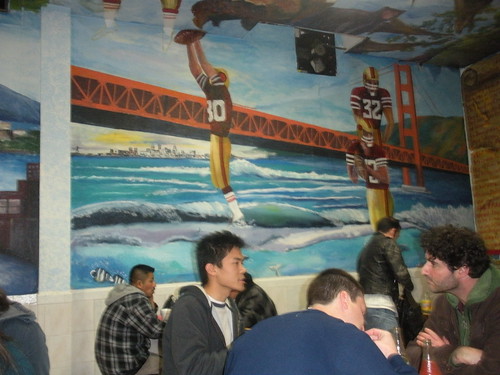
The food was delicious, and they were extremely accommodating of our large group! Most of the group went with some form of burrito or chimichanga, but many also enjoyed the taco bar. I got my usual vegetarian burrito. I get this at almost every taqueria I step foot in, which may seem boring, but also gives me a standard unit of measurement for how much I enjoy each place. This one was excellent, with perfect ratios of beans, cheese and rice, all well seasoned.
After a wonderfully filling meal, the 18 of us migrated from 24th & Balmy to Mission Pie at 25th & Mission. Mission Pie is a place I had heard a lot about but never gotten around to visiting. It is a fabulous concept incorporating locally grown produce at Pie Ranch with students at Mission High who all work together to grow the food and cook the pies at Mission Pie.
Mission Pie is a cozy spot that I look forward to coming back to. Though I don't reccomend going with a group of 18 people, they managed to accomodate us and one of the Mission High students even came and told us about the ranch and the shop. Then we enjoyed our delicious pie... and mmm it was good.

All in all another successful ESF outing, full of good people, good food, and good learning.
Check out my Yelp reviews for more specific descriptions of the food and overall experience at Taqueria Vallarta and Mission Pie.
25 February 2009
ESF does North Beach
Our first unit was on all things Italian. We watched the film Big Night, about a pair of Italian brothers who own an Italian restaurant in the United States, and learned about the history of North Beach, the Italian neighborhood in San Francisco. To encapsulate all of our new learning, we took a field trip to North Beach... check out this video of all the sights we saw and the foods we ate!
Makes you hungry, doesn't it? Check back at my blog soon for posts about Mexican food in the Mission, LGBTQ culture and dinner in the Castro, Dim Sum in Chinatown, and more!!!
